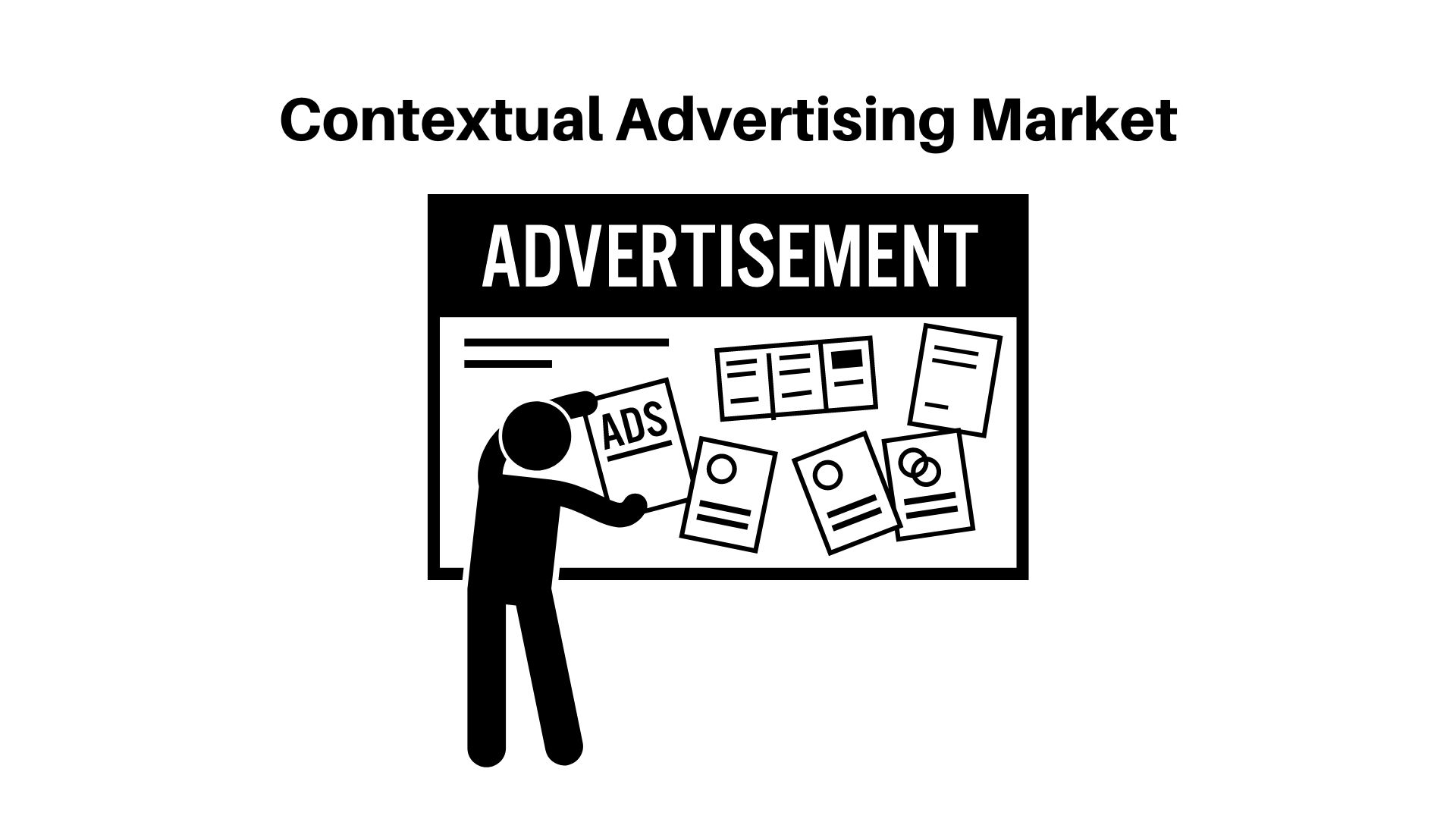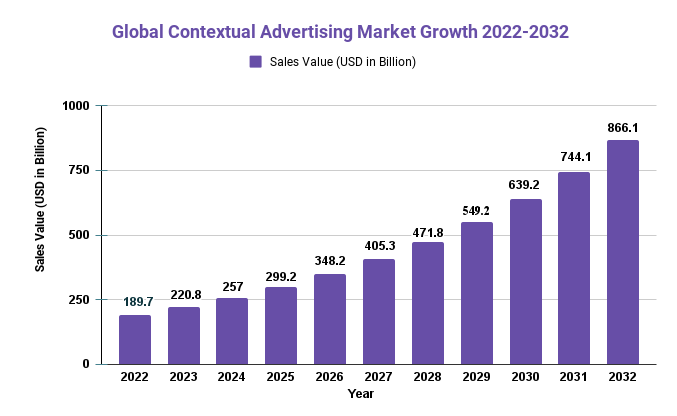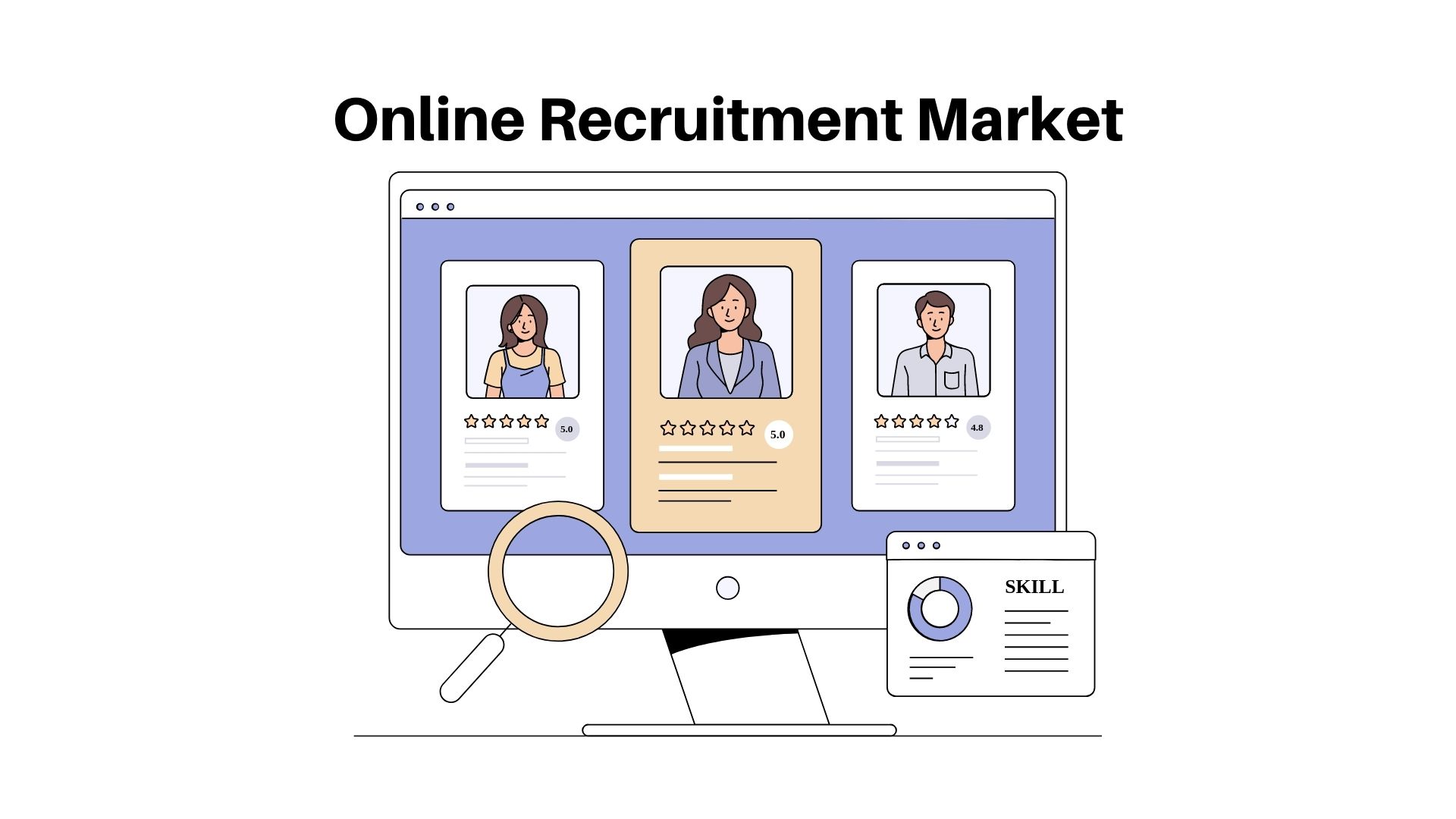Contextual Advertising Market Size USD 866.1 Bn by 2032| at a CAGR 16.4%

Page Contents
Market Overview
Published Via 11Press: In 2022, the contextual advertising market size was valued at USD 189.7 Billion and is projected to reach USD 866.1 Billion by 2032 at a compound annual growth rate (CAGR) of 16.4% from 2022-2032.
Contextual advertising market growth was steady and was expected to continue in the future. Contextual advertising is a form of online advertising that targets consumers based on the content of web pages they are viewing. By placing ads that are pertinent to that page's contents, viewers are more likely to find them interesting.
One of the primary drivers of growth in the contextual advertising market is an increasing reliance on digital media, as more and more people spend time online. Furthermore, advances in technology have made it simpler for advertisers to place ads on relevant websites and for consumers to engage with those ads – this includes using artificial intelligence and machine learning techniques which analyze website content and serve relevant ads in real time.
The COVID-19 pandemic has had a major effect on the contextual advertising market. As more people are spending time at home and online, there has been an uptick in online shopping and browsing activity – leading to greater demand for digital ads.

Drivers, trends, and challenges have an impact on market dynamics, which can impact businesses. Request for PDF sample report
Key Takeaways
- Contextual advertising is an online form that targets consumers based on the content of web pages they are viewing.
- Contextual advertising is on the rise and expected to remain so in the coming years due to rising digital media usage and technological advancements.
- The COVID-19 pandemic has seen a corresponding surge in online shopping and browsing activity, further driving up demand for contextual advertising.
Regional Overview
- North America has long been the leading market for contextual advertising due to its large internet user base and robust digital infrastructure.
- Europe is a major market for contextual advertising, with countries like the UK, Germany, and France contributing significantly to this industry.
- The Asia Pacific region is projected to experience the fastest growth in contextual advertising, due to the large and rapidly increasing population of internet users there, particularly in countries such as China and India.
- Other regions such as Latin America, the Middle East, and Africa are expected to witness growth in the contextual advertising market due to increasing internet penetration rates and digital adoption rates.
Drivers
- Growing Adoption of Digital Media: As more and more people spend time online, there is an increasing demand for online advertising. Contextual advertising provides advertisers with a way to reach consumers while they are engaged with relevant content.
- Modern technology: Artificial intelligence (AI) and machine learning (ML) have made it simpler for advertisers to analyze website content and serve relevant ads in real time, leading to improved targeting and higher click-through rates.
- Greater Personalization: Contextual advertising allows advertisers to tailor their messages based on the content of web pages consumers are viewing, increasing engagement and encouraging conversions.
- Shift Away From Programmatic Advertising: Programmatic advertising, which utilizes automated systems to buy and sell ad inventory, has become more commonplace in recent years. Contextual advertising lends itself perfectly to programmatic buying as it permits real-time bidding on relevant ad space.
- Growing Mobile Usage: With the growing use of smartphones and other mobile devices, there is an increasing demand for mobile advertising. Contextual advertising can be especially effective on these devices since it enables advertisers to target consumers based on their browsing behavior.
Restraints
- Privacy Concerns: As consumers become more aware of how their personal data is being collected and used, there is growing concerned about privacy. This could lead to greater regulation in the industry as well as restrictions on data collection and usage for consumers.
- Ad-blocking Software: Many internet users have installed ad-blocking software to prevent them from seeing online advertisements. Unfortunately, this can reduce the effectiveness of contextual advertising, as these ads may not be shown to those with ad blockers installed.
- Ad Fatigue: Consumers may become overwhelmed or annoyed with the sheer volume of online advertising, leading to a decrease in engagement and effectiveness. This could be especially true for contextual advertising, which relies on showing relevant ads to users.
- Lack of Transparency: Some advertisers and publishers may not be forthcoming with how they collect and utilize consumer data for contextual advertising, which could erode customer confidence and expose the industry to greater scrutiny.
- Competence from Other Advertising Formats: While contextual advertising can be effective, there are numerous other available formats such as social media advertising, video advertising, and influencer marketing that advertisers can choose from. This makes it difficult for contextual advertising to stand out and remain competitive.
Opportunities
- Growing Demand for Personalized Advertising: Consumers are increasingly expecting tailored advertisements tailored to their interests and needs. Contextual advertising can help meet this need by displaying pertinent ads based on the content of web pages users are viewing.
- Expansion into New Industries: Contextual advertising has long been used in retail and travel sectors, but its potential for expansion into other sectors such as healthcare, finance, and education could open up new partnerships and revenue streams for the industry.
- Integration with Other Technologies: Contextual advertising can be integrated with other technologies like augmented reality (AR) and virtual reality (VR), creating more immersive advertising experiences for consumers. This could present advertisers with new avenues to engage with their target market.
- Programmatic Advertising's Growth Potential: Programmatic advertising is expected to keep on rising in popularity, and contextual advertising fits perfectly into this platform. As such, programmatic advertisers could see an uptick in the use of contextual ads.
- The emergence of New Ad Formats: Native advertising and in-app advertising are becoming increasingly popular, and contextual advertising can be tailored to work with these formats. This presents the industry with new opportunities to reach consumers in creative new ways.
Challenges
- Ad Fraud: Ad fraud is a serious problem for the advertising industry, and contextual advertising is no exception. Fraudulent activity such as click fraud and impression fraud can reduce the effectiveness of contextual advertising while wasting budgets.
- Ad-blocking software: As previously noted, ad-blocking software can reduce the effectiveness of contextual advertising by blocking ads from being displayed to users who have them installed.
- Limited Access to Audience Data: Contextual advertising relies on website content to target ads to relevant viewers, yet advertisers may not have access to detailed information about who is viewing their ads. This makes it difficult to assess campaign effectiveness and optimize targeting.
- Targeting Complexity: While contextual advertising can be effective, it can also be challenging to target ads to the correct audiences. When selecting websites and pages on which to display ads, advertisers need to carefully consider factors like language, cultural context, and user intent.
- Advertiser and publisher resistance: Some advertisers and publishers may be unwilling to embrace contextual advertising due to concerns over privacy, transparency, or its potential impact on user experience. This could limit its adoption and growth in certain markets.
Recent Developments
- Technological advances in AI and machine learning have enabled contextual advertising to make significant progress, allowing advertisers to more precisely target their ads based on the content of websites and pages users are viewing.
- Programmatic advertising's growing adoption has allowed for an expansion in contextual targeting, as platforms can use algorithms to match ads with relevant content.
- The COVID-19 pandemic has caused a shift in consumer behavior, with more people shopping and consuming content online. This has resulted in an uptick in demand for online advertising – particularly contextual advertising.
- Privacy concerns have spurred an uptick in regulation for the advertising industry, with laws such as GDPR and CCPA placing limitations on the collection and use of consumer data for advertising purposes.
Key Market Segments
Type
- Activity-based Advertising
- Location-based Advertising
Application
- Consumer Goods, Retail, and Restaurants
- Telecom and IT
- Banking, Financial Services, and Insurance (BFSI)
- Media and Entertainment
- Travel, Transportation, and Automobile
- Healthcare
- Academia and Government
Key Market Players
- Beijing Miteno Communication Technology
- Microsoft
- Amazon
- Aol
- Yahoo
- IAC
- Amobee
- Act-On Software
- Simplycast
- Inmobi
- Flytxt
- Infolinks
- Adobe Systems
- Sap
- Marketo
- Millennial Media
Report Scope
| Report Attribute | Details |
| The market size value in 2022 | USD 189.7 Bn |
| Revenue forecast by 2032 | USD 866.1 Bn |
| Growth Rate | CAGR Of 16.4% |
| Regions Covered | North America, Europe, Asia Pacific, Latin America, and Middle East & Africa, and Rest of the World |
| Historical Years | 2017-2022 |
| Base Year | 2022 |
| Estimated Year | 2023 |
| Short-Term Projection Year | 2028 |
| Long-Term Projected Year | 2032 |
Frequently Asked Question
Q: What is contextual advertising?
A: Contextual advertising is a type of online advertising that targets ads based on the content of the web pages that users are viewing.
Q: How does contextual advertising work?
A: Contextual advertising uses algorithms to analyze the content of web pages and match ads with relevant keywords or topics. When a user visits a web page, the contextual advertising system will display ads that are relevant to the content on that page.
Q: What are the benefits of contextual advertising?
A: Contextual advertising can be an effective way to reach consumers with relevant ads, as the ads are displayed based on the content of the web pages that users are viewing. This can increase the likelihood that users will engage with the ads and take action
Q: What are the challenges of contextual advertising?
A: Contextual advertising can be complex to target effectively, and there are challenges such as ad fraud, ad-blocking software, and limited visibility into audience data. Additionally, some advertisers and publishers may be resistant to contextual advertising due to concerns about privacy and transparency.
Q: What is the future of contextual advertising?
A: The future of contextual advertising is likely to involve greater use of AI and machine learning to improve targeting accuracy, as well as integration with other technologies such as augmented reality and programmatic advertising. The industry will also need to address concerns around privacy and transparency in order to continue growing.
The team behind market.us, marketresearch.biz, market.biz and more. Our purpose is to keep our customers ahead of the game with regard to the markets. They may fluctuate up or down, but we will help you to stay ahead of the curve in these market fluctuations. Our consistent growth and ability to deliver in-depth analyses and market insight has engaged genuine market players. They have faith in us to offer the data and information they require to make balanced and decisive marketing decisions.



